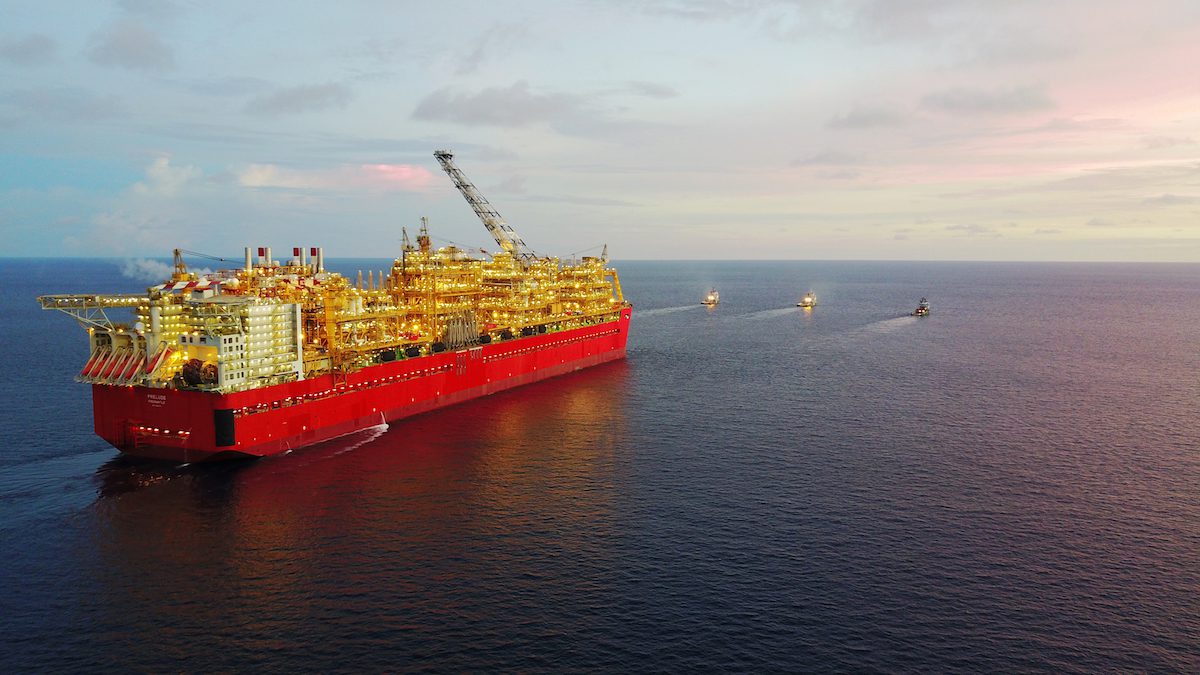Shell’s Prelude FLNG. Credit: Shell Australia
By Perry Williams (Bloomberg) — After a decade planning the world’s largest floating gas export plant, Royal Dutch Shell Plc’s supplies could get tapped by a competitor first.
Shell and Japan’s Inpex Corp. are both targeting gas from a connected reservoir in Australia’s remote Browse Basin, about 200 kilometers (125 miles) off its northwest coast, according to consultant Wood Mackenzie Ltd. Meeting its planned start up date this month would give Inpex’s Ichthys LNG project an edge over Shell’s Prelude LNG.
“The difference between Prelude starting six months before versus six months after Ichthys could be a few percent of their reservoir stake,” Wood Mackenzie analyst Saul Kavonic said in an email. “That is a material amount.”
The two projects, both due to start this year at a combined cost of about $50 billion, are being watched by energy majors intrigued by their different approaches to tapping remote fields. The 3.6 million-ton-a-year Prelude represents Shell’s biggest bet on floating LNG technology, which liquefies the fuel at sea before its loaded on tankers and shipped to buyers, eliminating the need for subsea pipelines to shore.
For Inpex, the Ichthys development is its most ambitious project and its costliest. With an annual capacity more than double Prelude’s, at 8.9 million tons, it plans to pipe gas 890 kilometers to an onshore plant near Darwin where it will be liquefied and exported.
While the two projects draw from separate fields, Prelude and Ichthys respectively, they may share gas at a reservoir called Brewster, according to a 2015 report by the Australian government-operated Geoscience Australia. As well, the National Offshore Petroleum Titles Administrator said the two fields may extend beyond the boundaries defined by their original exploration blocks, which are adjacent.
While Shell and Inpex are running separate projects, they aren’t strictly rivals. Inpex agreed to buy a 17.5 percent stake in Prelude in 2012, after the Tokyo-based company already took a final investment decision on Ichthys LNG. A map published by Inpex at the time showed the fields practically touching. The producers have also worked together on a joint response should a spill occur from the projects.
“They are connected reservoirs,” Shell Australia chairman Zoe Yujnovich said in an interview with Sky News on Dec. 20. “We also need to remember this is a reservoir that has a reasonably long life horizon and Prelude itself is something we expect will continue to be operating over decades.”
A Shell spokeswoman declined to comment on the implications of a shared reservoir.
Inpex fell 1.1 percent to 1,267.5 yen in Tokyo trading, compared with the benchmark Topix Index, which lost 0.5 percent.
The two fields aren’t connected, Inpex Senior Managing Executive Officer Masahiro Murayama told reporters Feb. 8 in Tokyo. Inpex is committed to the success of both projects, Bill Townsend, a general manager for Inpex external affairs in Australia, said in an email.
How the reservoir might straddle the Prelude and Ichthys fields will likely determine the position and timing of the projects’ separate drilling programs, John Davidson, founder of Hobart-based Exploration and Production Consultants said in a phone interview. Gas at the top of the Ichthys field may be in direct contact with Shell’s Prelude block, he said.
The two explorers may have already agreed on a process to divide up any gas flowing between the projects, according to Davidson. There are international precedents for similar deals, including a disputed oil find off Mexico last year. Both companies declined to say if there was a sharing agreement in place.
Even if gas is shared across the two fields, both projects likely have sufficient reserves to fulfill decades of planned LNG production. The 800-square-kilometer Ichthys field holds 12 trillion cubic feet of gas and 500 million barrels of condensate, which will provide 40 years of supplies, according to Inpex. The Prelude field contains three trillion cubic feet of gas, Shell says.
“There’s a lot riding on both companies to get this right,” said Davidson. “The shared volumes could be sizable.”
© 2018 Bloomberg L.P

 Join The Club
Join The Club











